African safari at the foothill of Mount Kilimanjaro, Amboseli National Park!
Amboseli National Park is a UNESCO heritage site that serves as a safe haven for herds of African elephants. And the herds are huge, rendering life to the idiom, “Mountain is moving as African elephants walk.” Conservation and tourism can work hand in hand, Amboseli is an example of that mission. Situated close by the Kenyan capital of Nairobi and the town named Arusha in Tanzania, Amboseli national park shares border with Kenyan neighbour Tanzania. Wildlife transverses the border at ease, in search of food and life resources.
The Masai used to call the land Empusel, referring to a dry and salty place. The new age explorers derived their own pronunciation, “Amboseli!”
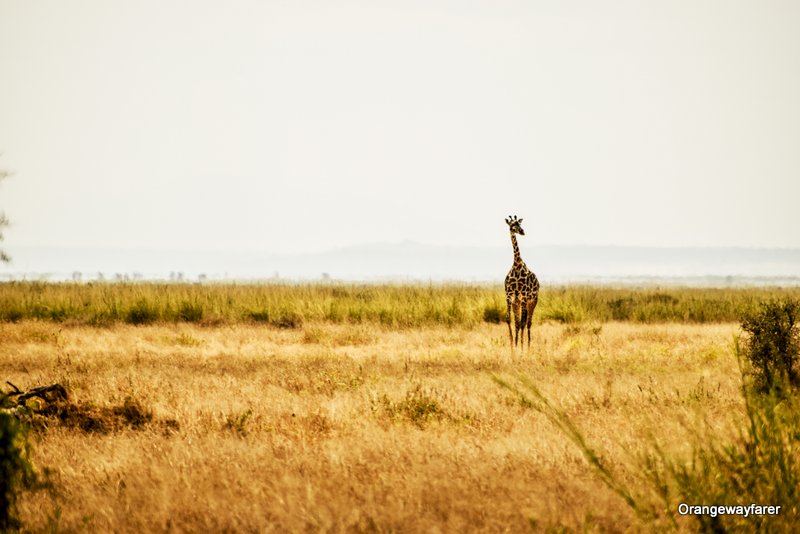
To Go or Not to Go: Choosing Amboseli National Park!
(As a day trip from Nairobi!)
While researching for Africa and a possible itinerary, I was looking up authentic and unique experiences that did not focus on the elusive BIG 5 ( lion, leopard, rhinoceros, elephant, and Cape buffalo). Not that I have anything particular in my mind about Big 5, the term originates from the degree of difficulty in hunting Africa’s wildlife. It feels horrible to continue with a culture that finds root in a game killing spree. But that is another story.
Amboseli came up as an obvious choice, surpassing Nakuru and Naivasha. The African elephants grazing on golden savanna as Kilimanjaro stands witness to magnificent sunrises and sunsets, I had to seal the deal with Amboseli. A few of the last great tuskers, considered a wealth of the world, have been living in the area as well!
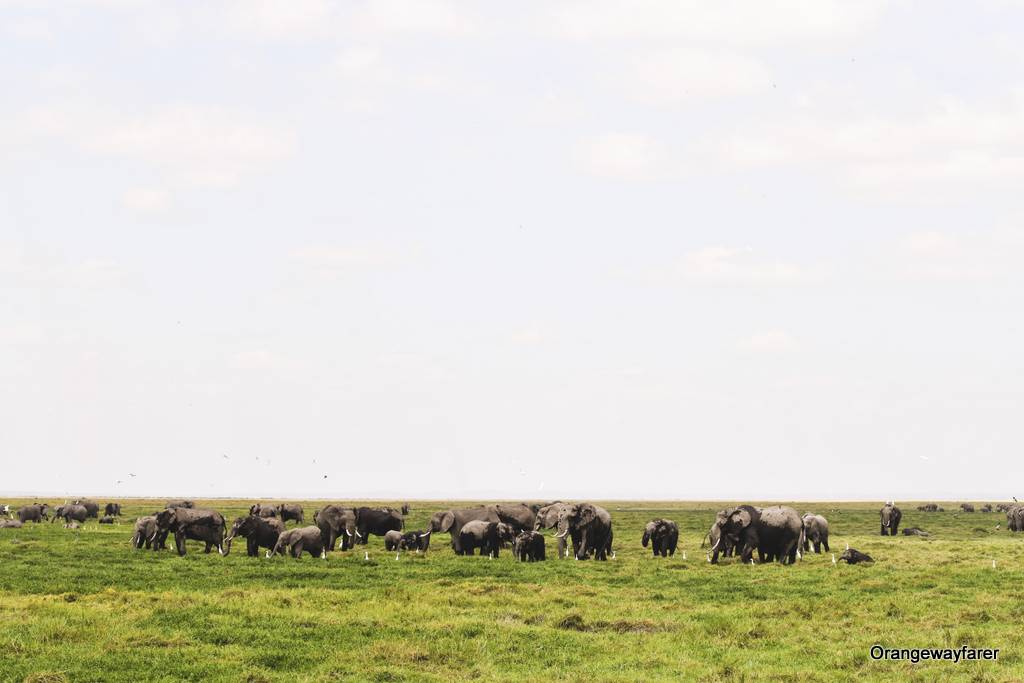
According to Dr Western, Amboseli national park offers the highest density of elephants anywhere on the continent.
Amboseli was one of the many ensuing road trips that we were going to take in Kenya and the first of all. We underestimated the road trip rigour and slept till late. The alarm went on screaming, crying, screaming again until our jet-lagged body decided to move at 8 am! Massive mistake, I tell you. while in Kenya, start as early as possible. Ideally at 5 in the morning, the sun still shy of showing the bright orange hues.
In case you are planning to stay in Amboseli for a few nights, take it easy and start a bit late, maybe. This way, you will still miss the sunrise by Kilimanjaro but hey, the next day awaits. Amboseli is huge and a couple of day’s game drive is easily possible in the park. Unless, you are in hurry to reach Mara, the most popular park in Kenya.
If you can drive, you can rent your own car and enter the park. I suggest renting a game drive specific Toyota minivans with a guide. The guide-driver will mostly know the route to the wildlife.

We were staying at the Eka Hotel, Nairobi. The huge breakfast buffet was served as early as 6 in the morning. By the time we started, the daily rush of office hours accompanied us! The highway is long stretched and heading towards Mombasa, the port town. The roads are winding to the horizon, with little Masai villages punctuating shortly. A young child stands witness to dwindling transit with a melon in her land. Her braided locks tinkle with air. A Masai man, tall and dark, stands with a spear in his hand. His red Shúkà flies as a flag, stating “this is Africa!”
Three hours of road dust comes to an end as we stopped at AA lodge for lunch. A few Impalas joined us from the other side of the fence. the woodpecker was busy in his nesting activities. Meanwhile, we were served spaghetti bolognese and banana walnut cakes. And finally entered the park through the Kimana gate.

A woodpecker at work!
Heading for Amboseli National Park from Nairobi? Be prepared for these unique experiences!
- Herds of elephants. the majestic animals will come and greet you at times on the road. Make sure to give them way on a priority basis. It is their home and you are the guest!
- Look out for the swamps. The green grass and traces of water serve as lifeline line for the residents. And it is here you can spot the maximum number of wildlife.
- Go for the observation hill and pack a lunch here.
- Kilimanjaro. You can never have enough of the mountain! Wait till a sunset! Thank me later?
- Look out for the birds. the park is home to 400 species of birds. My favourite? The flamingoes, of course!
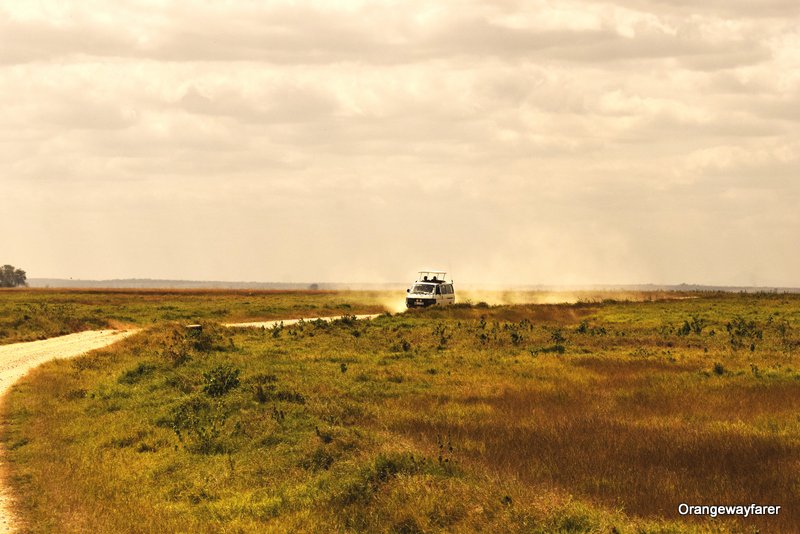
It was August, a few months after the cruel summer of Africa had taken leave. However, Amboseli retained its arid, lifeless straw-yellow appearance. The ice cap of Kilimanjaro melts with warm sun and provides a natural irrigation for the land. Salt lakes are otherwise dried up, forcing elephant herds to move in search of the swamps. My Indian eyes search for the dense jungles we have been taught and shown since a child. We do have the Himalayas presiding over an enriched jungle life for a greater part of the country. Africa laughs in her mind, I guess and opens the Kimana gate.
Black on White or White on Black?
For everyone who has dreamt of visiting Africa, the black and white stripes of Zebras must be a muse. “These are donkeys, painted.” A Reddit thread read once. Whatever they are, Zebras are beautiful. The monochrome stripes laid on the urban roads for safeguarding jaywalkers come alive in the African savanna grasslands. They move, graze, exchange niceties with the migrating lot of wildebeests, respond nonchalantly at the minivans.

These African equids were never truly domesticated. Even though Rothschild took a couple of Zebras and drove a carriage with them to Buckingham Palace, it is safe to say the gimmick did not last long, for good.

A large harem of zebras looks and feels like a huge animal, unique in its form, from a distance. You bet, the lion thinks twice before deciding on his prey.
Kilimanjaro Malai Kani Manajaro
(Click on the name and watch this video by Indian movie icons!)
The initial excitement of spotting a zebra died down soon. We spotted quite a lot of the harems. one two three… we started taking a count and soon reached sixty-eight and stopped. We stopped because the clouds flew away and a magnificent mountain showed on the Western side!
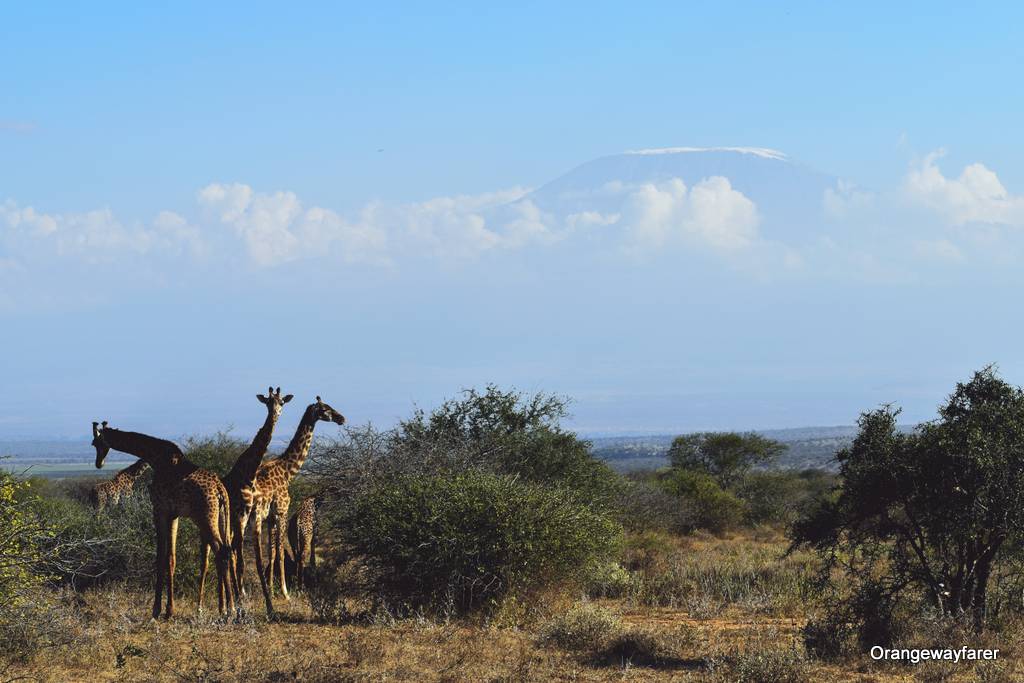
How can you not fall in love with the roof of Africa?
The usual Africa wild reserves have savanna grassland running on an endless plain. There will be a brief period of sparse green swamps. A profound nothingness is evident where the land ends. Looking at which, you know why the ancient scholars thought the world to be a flatland. Kilimanjaro emerged from that emptiness.
The tallest standing mountain of the African continent plays hide and seek with clouds floating by. The sunrise and sunsets are particularly endearing at Amboseli (unless you are flying at the that over Kilimanjaro).
Every photographer wanted to shot a herd of tuskers walking gracefully as Kilimanjaro stands witness at the back. The ice peaks of glaciers constantly recede to the Uhuru Peak, meaning “Freedom Peak” in Kiswahili. The mountain’s glacier water irrigates the arid land of Amboseli, which suffers bouts of draught very often.
The Gentle Giants: Elephants of Amboseli National Park!

Elephants in Amboseli are iconic. Nowhere else in the world you can spot a matriarch leading a herd of around 60 elephants. The gentle giants are pretty used to with the minivans these days. Some of them are posers too! The calf trots behind its mother with an inquisitive look lingering on us. At times it leans against the mother and keeps a watch at us!

Drink as much as you can!
The arid land often pushes the elephant herds at Amboseli to be on the lookout of the swamps. The dried salt lake of the park makes the situation tougher for the thirsty animals.
If merciless natures were not enough, the African elephants are in constant threat of poaching. The receding number of tuskers are proved how the species is evolving with time. A constant demand of ivory trade (in Hongkong, the sale of ivory is rampant on the streets) gets only fueled with the Chinese construction companies smoothing African surface. The roads are far fetching, new and growing by the day, making it easier for poachers to flee faster, move faster. The African savanna soaks the blood of massive elephant carcasses.

“Elephants are mystical creatures. And they seem aware of us. They look us in the eye.”
The tusker Satao knew his life was in danger for the ivory. He would hide them behind the bush and walk miles for quenching his thirst. He would not leave any trace and not be regular at the water source. Satao could not save himself at the end. His tusks were ripped apart and he was mauled, left to die. For past hundred years, the African elephants are born with a visibly shorter tusk. Nature works in mysterious ways.

Spotted him at Longinye Swamp. Not a tusker. We did not spot any tusker at Amboseli.
The increasing demand for tourism, on the other hand, is directly impacting the conservation efforts taken by the government and organizations with goodwill. Not only it arranges for an alternative livelihood for the local community (and remember, Masai had historically been averse to game meat and respectful to animal spirit), it also rekindles the pride for their land, their forest and heritage shared over millennia! Every guide I spoke with in Africa, abhors poachers, to an extent that at first, it will sound like they are bad mouthing Chinese! Hear them well, and you know they are frustrated with the Far East and Chinese demand for animal organs, especially rhino horns and ivory.
The birds of Amboseli!
Amboseli will also astound you with its resident birds. When you spot the lake Amboseli from afar (and if you have never seen a flamingo before), you will easily mistake the school of flamingos as a dense brunch of white flowers in bloom. Their tall, red legs, emerging straight from the shallow water resembles lotus stem.
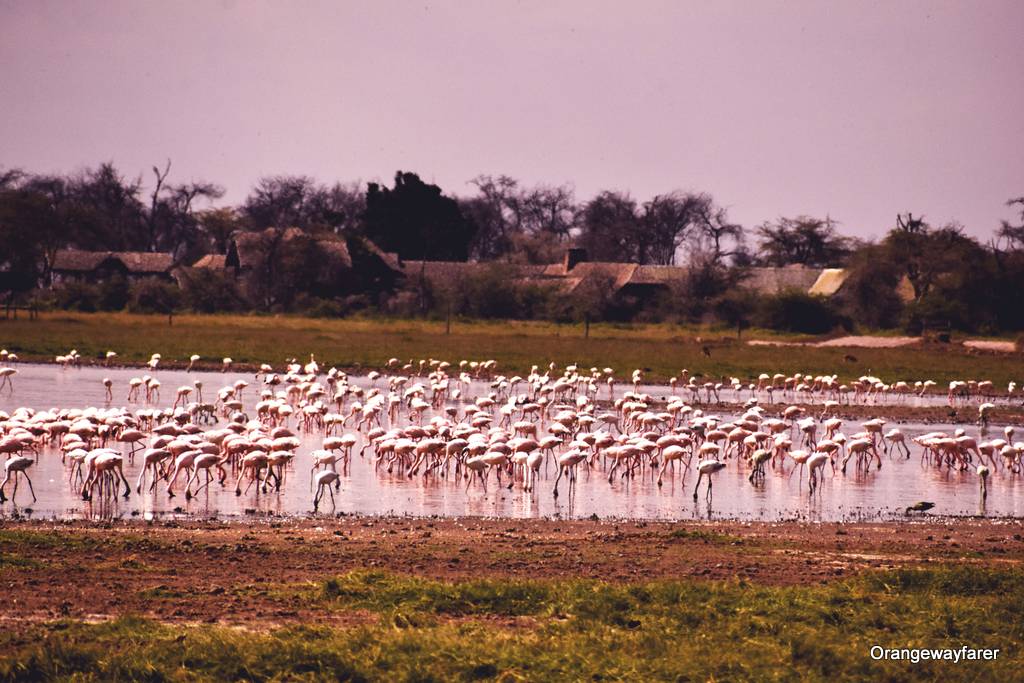
We came near, a bit nearer. They did not take any plight. Nature knows the rules of co-existing confidently. Tolerance is practised.

The very Amboseli locals: Weaver bird Nests on Acacia trees.

It was never about the Big Five…
For me, a safari is never about spotting predators. Sure I will be exhilarated to find one, but the sheer pleasure of watching an animal in its natural habitat surpasses the elusive big cat hunt. Amboseli National Park has pride of lions, often hidden in the bush or camouflaged in the golden savannah. We learnt lions and cheetah can be spotted occasionally but that is not the norm here.

If you are deciding on a day trip to Amboseli from Nairobi, be aware of the following:
- You should ideally get one driver/guide with a minivan. A minivan fit 4 people comfortably, has a sitting arrangement for 6/8 people.
- Shop around at Nairobi for the best price. In general, a car will charge you USD 180 for a day that includes driver’s entry fee as well. You pay extra for Amboseli national park entry (USD 60 for adults and non-resident Kenyans).
- Self-drive is an option if you have your own mode of transport.
The best time to visit: January, February, June – September. I visited in August and loved it. Do avoid rainy season (April, May, November and December) since roads are in bad shape. - We stopped at AA lodge for lunch. There were elaborate arrangements of food with efforts being in place to please the Asian platter. Rice and chicken and fruits were in place. Mixed vegetable should be your pic if you are a vegan.
- If you are planning to stay for a night, bring your snacks and soft drinks from the town.
- Also, opt for a hut/cottage/accommodation that lets you take lingering views of Kilimanjaro. You will never regret this decision! Be informed that prices will vary dramatically.
- If it is a day trip from Nairobi, you need to be back before it is dark. the roads are closed and void of light as well. Make it a point to leave the park by 4 pm at best.

Want to book a stay for the Amboseli National Park?
This post may contain affiliate links. Please read the disclosure post. If you have liked the article, you may support it by buying using these links without any extra cost to you
Want to get real time updates of my travels?
Get updates and read additional stories on the Orange Wayfarer Facebook page.
Follow Orange Wayfarer on Instagram.
Follow Orange Wayfarer on Twitter.
You may also subscribe to my weekly newsletter!
Beautiful photographs ….. seems like a wonderful experience. Thanks for sharing …… we just took a trip along with you 🙂
Your photos are amazing! What an incredible adventure. Elephants are my favorite animal and I would love to do this one day. I am saving this post, you gave such great information here. Thank you!
Thank you so much for sharing! You are right – everybody is always so focused on the Big 5, but there is so much other wildlife to admire in Africa. This post makes me want to go back to Africa the soonest!!
Ok, I LOVE THIS so much. Thank you for bringing this park to people’s attention, and thank you for the appreciation for things beyond chasing the big 5! I would way rather see herds of elephants, anyway!! I just climbed Kili this past summer and took clients on a safari in the Ngorongoro, but honestly, if I had been by myself this would have been so much more awesome. Plus, having a view of Kilimanjaro wouldn’t be so bad either 😉
Absolutely gorgeous! I’m definitely going next year on safari so help me God because our vacation days in USA are criminal! I truly hate Europeans coming to the continent and killing off our wildlife just to hang on their walls…but that’s another story like you said. I cannot wait to see all these in their natural habitat instead of in zoos.
I am so doing this one day. Thanks for great amount of detail.
Your photos are absolutely amazing and this seems like a great adventure. Would love to try it someday 🙂
Wow this is incredible! I have been trying to plan my grand African journey for 2020 and this will be so beneficial. Your photos are breathtaking and makes me want to go to Kenya now and will now have to consider it!
Oh my God, that baby elephant on the road totally got me:) So cute! I hope I will get to do this one day! Pinned it for the future, thanks for all the practical information!
Wow this looks breathtaking! I have always wanted to see animals in their natural habitat and this looks just stunning – time to persuade my husband to visit Kenya for our next trip!